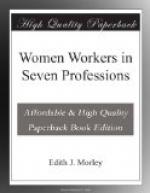The pioneer girls’ schools of the nineteenth century did much experimental work and established the right of individual initiative and a distinct line of work for each school. Perhaps special gratitude is due in respect of this to the governing body of the Girls’ Public Day School Trust, since its schools were numerous enough soon to create a tradition requiring for their Headmistresses great initiatory power and considerable freedom.
“This freedom,” writes a recently retired Headmistress of thirty-six years’ standing (Mrs Woodhouse, late of Clapham High School), “was of the greatest value as leading to differentiation of type and character of school. It ensured a spirit of joy in work for the whole staff; for the Headmistress and her band of like-minded colleagues were co-workers in experiments towards development and sharers in the realisation of ideals. The vitality thus secured has been appreciated at its true value by His Majesty’s Inspectors when in recent years they have come into touch with these schools, and as far as my experience goes, they have left such initiative untouched.”
The danger resulting from the progress made in education during the twentieth century is that secondary schools, coming as nearly all now do under the cognizance if not the control of the Board of Education, may become too much office-managed and State-regulated, thus losing life in routine. The task of resisting this, of working loyally with local and central government departments, and yet of keeping the school a living organism and not merely a moving machine is one requiring by no means ordinary ability. Is there not here a call to women of the highest power and academic standing?




